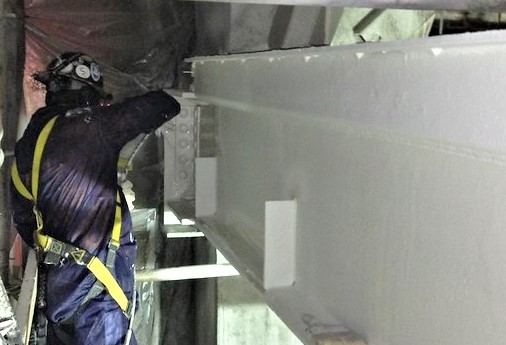Fire retardant

|
| Workers apply intumescent paint to a floor beam at the 44th Street facility. Source: MTA Construction & Development Mega Projects. |
Contents |
[edit] Introduction
A fire retardant is a substance such as a coating, powder, foam, gel or spray, that is used to slow - and eventually stop - the spread of fire. It is a preventive measure that can help limit a fire’s spread by triggering a chemical reaction.
[edit] History
The earliest form of fire retardants (which were thought to have originated many centuries ago) were substances such as vinegar, alum and clay that were used to treat timber and some fabrics.
More complex fire retardants were introduced in the 19th century in the form of flame retardants for fabrics. These were developed by Joseph Louis Gay-Lussac, a French chemist who made a number of discoveries in the idea of temperature and its relationship to gas pressure (Gay-Lussac’s Law or Amontons's law).
His exploration of the use of salts as fire retardants was groundbreaking, but it wasn’t until the 1900s that more effective measures would be introduced in the form of flame retardants.
[edit] Fire retardant or flame retardant?
Modern fire retardants and flame retardants have similar purposes - to control fires - but they achieve this by different methods:
- Flame retardants are chemicals (such as aluminium hydroxide) usually applied to combustible materials (such as textiles, plastics and coatings).
- Fire retardants are chemicals (for example, ammonium and diammonium sulfate) that can also be used on surfaces, but different types of chemicals are used for different purposes. Fire retardants as extinguishers include chemicals that will absorb a great deal of heat to cool whatever has been treated. Other agents will react with the heat to put out the fire by releasing water vapour or carbon dioxide. This is a physical process called dilution. Other fire retardants are intumescent coatings (such as paints or plastic additives). These rely on substances that will expand through a chemical reaction when heated to protect the materials that have been coated. For more information see: Intumescent coatings.
NB Fire retardants can also be dropped from planes to extinguish forest fires.
[edit] Related articles on Designing Buildings Wiki
Featured articles and news
Infrastructure that connect the physical and digital domains.
Harnessing robotics and AI in challenging environments
The key to nuclear decommissioning and fusion engineering.
BSRIA announces Lisa Ashworth as new CEO
Tasked with furthering BSRIA’s impressive growth ambitions.
Public buildings get half a million energy efficiency boost
£557 million to switch to cleaner heating and save on energy.
CIOB launches pre-election manifesto
Outlining potential future policies for the next government.
Grenfell Tower Inquiry announcement
Phase 2 hearings come to a close and the final report due in September.
Progress from Parts L, F and O: A whitepaper, one year on.
A replicated study to understand the opinion of practitioners.
ECA announces new president 2024
Electrical engineer and business leader Stuart Smith.
A distinct type of countryside that should be celebrated.
Should Part O be extended to existing buildings?
EAC brands heatwave adaptation a missed opportunity.
Definition of Statutory in workplace and facilities management
Established by IWFM, BESA, CIBSE and BSRIA.
Tackling the transition from traditional heating systems
59% lack the necessary information and confidence to switch.
The general election and the construction industry
As PM, Rishi Sunak announces July 4 date for an election.
Eco apprenticeships continue help grow green workforce
A year after being recognised at the King's coronation.
Permitted development rights for agricultural buildings
The changes coming into effect as of May 21, 2024.





















